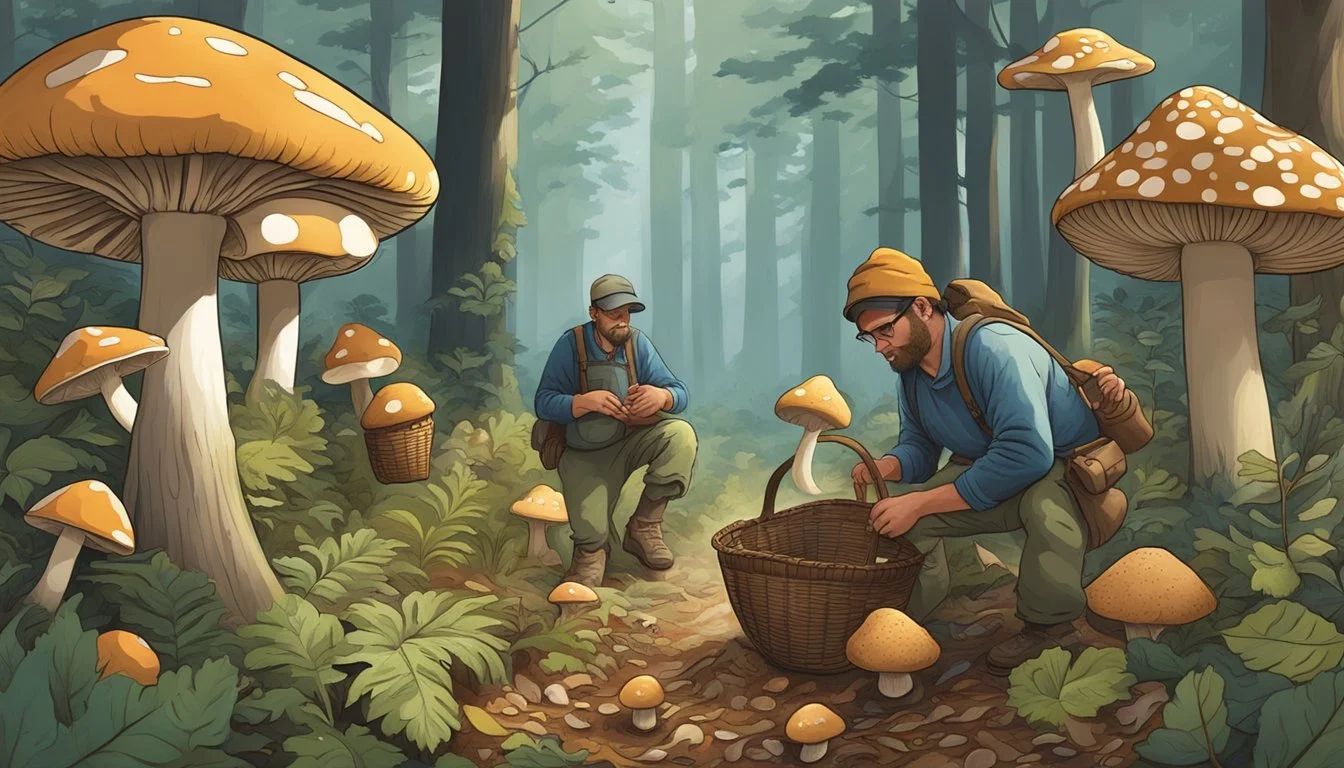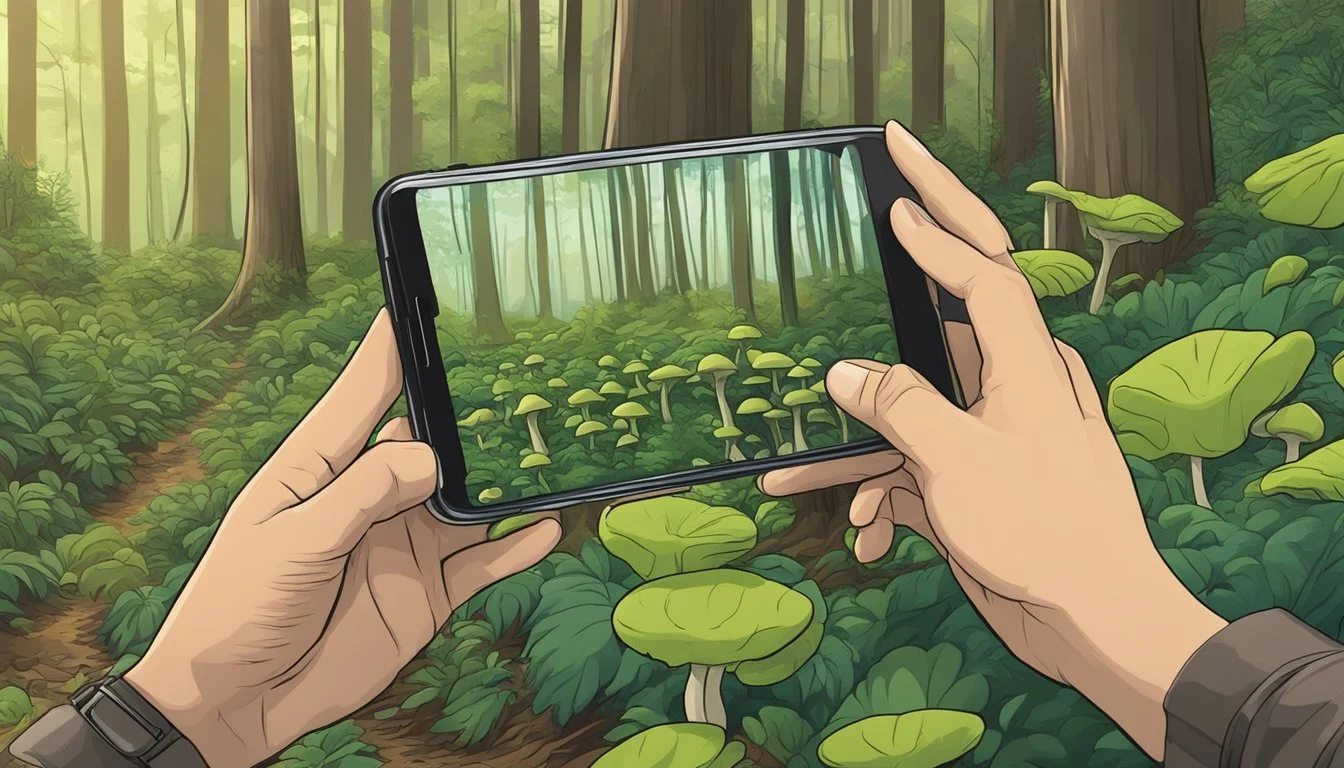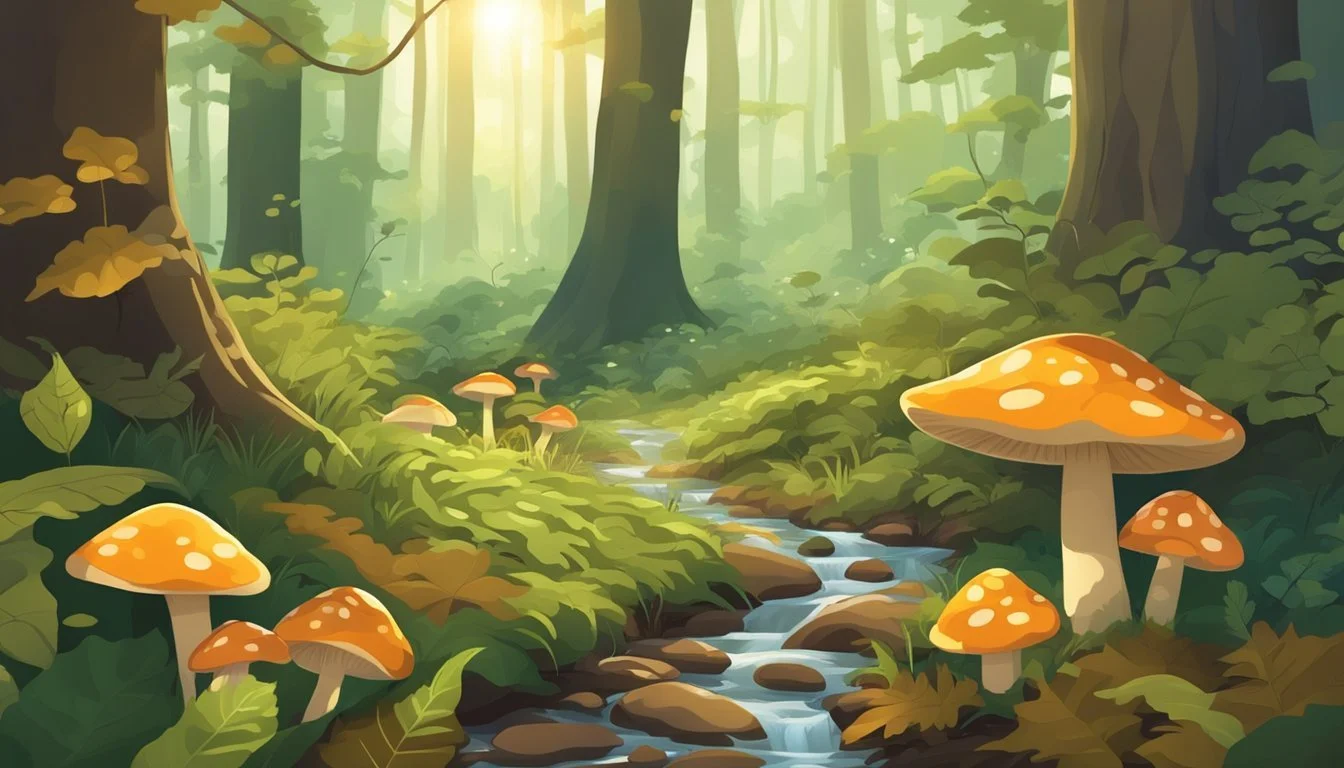Chesapeake Bay Mushroom Hunting
Expert Tips and Best Practices
Mushroom hunting in the Chesapeake Bay area offers an exciting opportunity to explore the unique and diverse ecosystems of Maryland. Enthusiasts and beginners alike can find a variety of fungi, from the coveted morels to the fascinating macabre mushrooms. The region's rich landscapes, including saltwater marshes and forested areas, create the perfect conditions for these fungi to thrive.
Jared Urchek’s forays, organized by the Chesapeake Bay Program, provide an excellent gateway for those looking to learn more about the hidden world of forest fungi. Participants, guided by experts like Beth Sanders and Santino Lauricella, embark on explorations where they might discover both common and rare species. Whether you're a seasoned mycophile or a curious nature lover, these outings promise to enhance your understanding and appreciation of the region's fungal biodiversity.
The Chesapeake Bay area's mushroom hunting excursions stand out not just for the sheer variety of fungi but also for the immersive experience of Maryland’s natural beauty. Joining a guided hunt or setting out on your own with proper maps and layers can reveal the intricate and often overlooked world of these remarkable organisms.
History and Importance of Chesapeake Bay
Chesapeake Bay has played a critical role in the development and ecology of the surrounding region. Significant efforts have been undertaken to preserve its natural beauty and ecological importance.
Conservation Efforts
Since 1983, the Chesapeake Bay Program has led efforts to restore and protect the Bay. This partnership involves various stakeholders, including federal and state agencies, local governments, non-profit organizations, and academic institutions.
Key initiatives include reducing nitrogen and phosphorus pollution from agricultural runoff and urban sources. These nutrients can cause harmful algal blooms that deplete oxygen in the water, harming fish and other wildlife. Efforts also focus on habitat restoration, such as replanting underwater grasses and protecting wetland areas.
Public engagement is a cornerstone of these efforts, encouraging local communities to participate in clean-up campaigns and advocacy. The Chesapeake Bay Total Maximum Daily Load (TMDL), known as the Bay's "pollution diet," sets quantitative limits on the amount of certain pollutants allowed to enter the Bay.
Role in Maryland's Ecosystem
Chesapeake Bay serves as a vital resource for Maryland's ecosystem, acting as a habitat for numerous species of fish, birds, and other wildlife. The Bay supports commercial fish and shellfish industries, which are economically significant for the region.
Blue crabs (Callinectes sapidus), an iconic species of the Bay, have been extensively studied. Long-term surveys help manage their populations sustainably. Additionally, the Bay's wetlands and marshes provide crucial breeding grounds and refuge for migratory birds.
Oysters play a unique role in filtering the Bay's waters, improving water quality. Conservation projects have focused on oyster reef restoration to enhance these effects. Protecting these ecosystems ensures the survival of both common and endangered species, contributing to the overall health and diversity of Maryland's natural landscape.
Basics of Mushroom Hunting
Mushroom hunting involves identifying and collecting wild mushrooms from various habitats. Essential aspects include understanding where mushrooms grow and what gear to bring for safe and successful foraging.
Understanding Mushroom Habitats
Different mushrooms thrive in various ecosystems. For instance, loamy soil, a mixture of sand, clay, and organic matter, provides an excellent growing medium. Stream and creek areas offer high moisture levels beneficial for mushroom growth.
Swampy regions, even in hot weather, can yield abundant finds due to the consistently moist environment. Always look for shaded areas, such as under trees and fallen logs, which offer shelter and decomposing organic material mushrooms need.
Essential Equipment for Foraging
Successful mushroom hunting requires proper equipment. A notebook and pen help document finds and locations. A magnifying glass assists in examining mushroom details and differentiating species, crucial for safety.
Bring a knife or special mushroom cutter for harvesting. Use a basket for carrying mushrooms to avoid crushing them.
Wear waterproof clothing and sturdy boots to navigate different terrains comfortably. A backpack is useful for carrying essentials like a field guide, water, snacks, and a first-aid kit. If foraging in low-light conditions, a headlamp or flashlight is indispensable.
These tools contribute to a safe and productive foraging experience.
Foraging Guidelines and Safety
Foraging for mushrooms around Chesapeake Bay requires thorough knowledge of identification and a robust understanding of legal and ethical practices. Being well-informed ensures both a successful harvest and the preservation of local ecosystems.
Identification and Harvesting
Accurate identification is crucial to safe mushroom foraging. Many edible mushrooms have toxic look-alikes. For example, morels are popular but have false morels that are hazardous. Using field guides with detailed photos, like the Wild Mushroom Guide, can aid in distinguishing species.
When harvesting, it's vital to pick mature mushrooms and leave younger ones to ensure future growth. Carry a basket with ventilation to keep mushrooms fresh and perform a spore print test to confirm identity.
Legal and Ethical Considerations
Adherence to local laws is mandatory in any foraging activity. In Maryland, it's important to check if the area has specific regulations on mushroom picking. Some parks or private lands may require permits or may prohibit foraging entirely.
Ethical foraging involves respecting nature. Do not overharvest; leave ample mushrooms behind to maintain ecological balance. Never forage endangered species and always tread lightly to minimize environmental impact. Only foraging within allowed areas helps preserve these natural resources for future generations.
Top Mushroom Species in Chesapeake Bay
Chesapeake Bay's rich biodiversity offers a variety of mushrooms, with oyster mushrooms and chanterelles among the most coveted finds. These mushrooms not only contribute to the ecosystem but are also sought after for their culinary value and nutritional benefits.
Finding and Identifying Oyster Mushrooms
Oyster mushrooms (Pleurotus ostreatus) thrive on deciduous hardwood trees, especially beech and oak. They typically grow in clusters on dead or dying wood, logs, and stumps.
Look for their fan-shaped caps which can be white, gray, or tan. Oyster mushrooms have a smooth surface and a slight funnel shape. Gills on the underside of the caps run down the stem, which is usually short or absent.
These mushrooms are prized for their mild flavor and versatile culinary uses. They are rich in protein, vitamins, and minerals, making them a healthy addition to meals.
Hunting for Chanterelles
Chanterelles (Cantharellus cibarius) are another top species in the Chesapeake Bay area. They favor moist, mossy areas in mixed forests, often near oaks, conifers, and birch.
Key identification features include their trumpet-shaped cap with wavy edges and a smooth, shiny surface. Chanterelles range in color from bright yellow to orange. False gills that fork and appear almost as ridges run underneath the cap.
Known for their fruity aroma reminiscent of apricots, chanterelles are edible and highly prized. They provide essential minerals and are loaded with antioxidants, maintaining their place in both culinary and medicinal applications.
Integrating Technology in Mushroom Hunting
Advancements in technology have significantly enhanced the mushroom hunting experience in Chesapeake Bay. Apps and guides provide essential information, while documenting finds helps track progress and contributions to mycology.
Using Apps and Guides
Modern apps can help mushroom hunters identify species, find optimal locations, and understand growth patterns. Mushroom ID apps, for instance, use image recognition to match photos of mushrooms with a comprehensive database.
Weather-based apps are also valuable. They predict the best times and places for mushroom growth by analyzing habitat conditions. The Magic Mushroom Map forecasts growth based on recent weather patterns.
Hunters should also carry digital or print guides. These resources often include detailed pictures, habitat descriptions, and potential look-alikes to help users differentiate between edible and poisonous varieties.
Documenting Your Finds
Documenting mushroom finds is essential for both personal tracking and scientific contribution. Photographs can capture the unique features of each mushroom, and many apps allow annotation for additional notes such as location and conditions.
Hunters can log their observations in digital journals, creating a valuable data set over time. Platforms like iNaturalist facilitate this by enabling users to upload photos and details, contributing to a global database.
Art can also play a role. Sketching or painting mushrooms provides another layer of documentation, capturing subtle details that might be missed in photos. These artistic records can supplement scientific data, offering a richer perspective on the mushrooms found in Chesapeake Bay.
Culinary Applications
Mushrooms from the Chesapeake Bay area offer diverse culinary possibilities and methods of preservation. These fungi not only add unique flavors to dishes but also provide health benefits and can be stored for long-term use.
Cooking with Wild Mushrooms
Wild mushrooms can be used in various ways in the kitchen. One popular technique is sautéing. For instance, cook Morel mushrooms in oil until they develop a golden color, then add a pinch of salt and a splash of sherry vinegar to enhance their earthy flavor. Chanterelles, another common variety, pair well with garlic and herbs in pasta dishes.
Another method is roasting. Toss cleaned mushrooms with olive oil, salt, and pepper, and bake them until slightly crispy. This method works well for incorporating mushrooms into salads or as a topping for steaks. Avoid overcooking as it can result in a rubbery texture.
Preservation Techniques
Storing wild mushrooms properly extends their shelf life. Drying is a reliable method. Slice the mushrooms thinly and place them in a dehydrator or an oven at low temperatures until fully dehydrated. Dried mushrooms can then be stored in an airtight container and rehydrated in water when needed.
Freezing is another option. Blanch the mushrooms quickly in boiling water, then cool them in an ice bath. Place the blanched mushrooms on a tray to freeze individually before transferring them to a freezer bag. This preserves their flavor for future use.
Pickling can also retain the mushrooms' taste while adding a tangy twist. Use a vinegar-based brine with spices such as mustard seeds, garlic, and dill. Store the pickled mushrooms in sterilized jars for a delightful addition to salads and cheese boards.
Understanding the Ecosystem
The fungi in Chesapeake Bay forests play crucial roles in breaking down organic matter, supporting wildlife, and maintaining ecological balance. This ecosystem is impacted by both native species relationships and challenges from invasive species.
Relationship with Wildlife
Fungi form symbiotic relationships with many forest plants and animals. Mycorrhizal fungi connect with plant roots, aiding in nutrient absorption and improving plant health. These fungi help trees like oaks and beeches thrive.
Decomposers like mushrooms break down dead organic material, recycling nutrients back into the soil. This process supports insect populations that feed on decaying matter, providing food for birds and small mammals.
Some fungi, such as the Lion’s Mane, are integral to the diet of various animals. This mushroom is not only consumed by humans but also by wildlife, highlighting its role in the forest food web.
Impact of Invasive Species
Invasive species disrupt the balance of the forest ecosystem. Certain non-native fungi can outcompete local species, reducing biodiversity. This impact can be detrimental to native plants that rely on specific fungal partners.
Fungal diseases, such as Dutch Elm Disease and Chestnut Blight, have devastated tree populations in North America. These diseases often spread through fungal spores, causing widespread damage to forests.
The presence of invasive plants can also influence fungal communities. Non-native plants may alter soil chemistry, negatively affecting mycorrhizal relationships. This change can reduce the effectiveness of native fungi, impacting plant health and overall forest vitality.
Complementary Outdoor Activities
Beyond mushroom hunting, there are several other engaging activities in the Chesapeake Bay area. These offer visitors opportunities to explore natural beauty and engage in unique experiences.
Waterfowl Hunting in Chesapeake Bay
Waterfowl hunting, including sea duck hunting, is a popular pursuit. The bay hosts species like canvasbacks, mallards, and teal. Hunting takes place in marshes and open waters, often requiring boats and blinds.
Guided tours with a master captain can enhance the experience, providing expert knowledge. It's important to check local regulations and seasons to ensure a legal and ethical hunt. Equipment includes decoys, shotguns, and appropriate attire for cold, wet conditions.
For beginners, safety courses are recommended. Experienced guides ensure compliance with environmental and safety standards while offering tips on effective hunting strategies. The beauty of the landscape and the thrill of the hunt make it a memorable adventure.
Exploring Maryland's Eastern Shore
The Eastern Shore of Maryland offers numerous outdoor adventures. Known for its scenic beauty, this area is ideal for hiking, birdwatching, and fishing.
Parks and wildlife refuges like Blackwater National Wildlife Refuge provide habitats for a variety of birds, including bald eagles, great blue herons, and many migratory species. Trails and boardwalks let visitors observe wildlife in their natural settings.
Fishing in the Choptank River and Chesapeake Bay is another major attraction. Anglers can catch species like striped bass, bluefish, and white perch. Chartering a boat with a local guide can enhance the experience, catering to both novice and experienced fishermen.
Kayaking and canoeing are popular as well, allowing exploration of quiet coves and marshes. These activities provide a close-up view of the region's diverse ecosystems. Local outfitters offer equipment rentals and guided tours to ensure a safe and enriching experience.
Exploring Maryland’s Eastern Shore offers a blend of relaxation and adventure, underpinned by the natural beauty of the Chesapeake Bay area.








